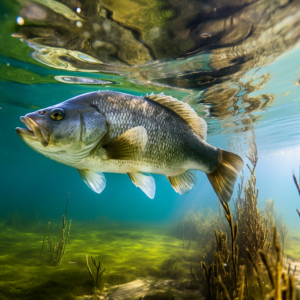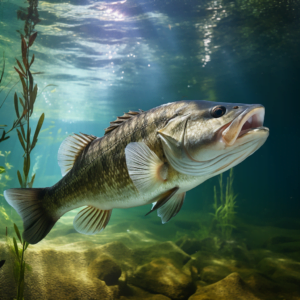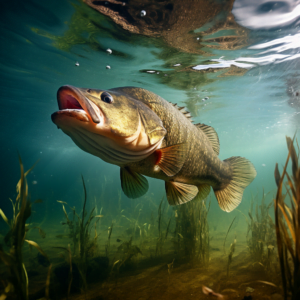So, you’ve been out on the water, casting your line and hoping to catch a big bass. But for some reason, it seems like those elusive fish just keep slipping away. Well, my friend, you’ve come to the right place. Today, we’re going to dive deep into the world of bass fishing and unlock the secret to reeling in those prized trophy fish.
Now, let me tell you, catching bass is not as easy as it may seem. These fish are smart and can be quite tricky to lure in. But fear not, because with the right knowledge and techniques, you can increase your chances of success. In this ultimate guide, we’ll cover everything from choosing the perfect fishing spot to selecting the right bait and mastering different fishing techniques.
If you’ve ever wondered why some anglers seem to have all the luck when it comes to catching bass, this article is for you. We’ll reveal the secret strategies that experienced fishermen swear by, and share insider tips that will have you reeling in those big bass in no time. So, sit back, relax, and get ready to become a bass fishing pro. Trust me, by the end of this article, you’ll have all the tools you need to improve your bass fishing game and catch that dream fish you’ve been chasing. If you’ve ever tried your hand at bass fishing, you know that it can be a thrilling and rewarding experience. Bass, known for their strength and fighting abilities, are a popular sportfish that attracts anglers of all skill levels. But what is the secret to catching bass? In this ultimate guide, we will explore the different types of bass, their behavior, essential fishing gear, techniques for catching bass, choosing the right location, weather and fishing conditions, understanding bass diet, proper casting techniques, and the importance of patience and persistence. By the end of this guide, you’ll be well-equipped to master the art of bass fishing.
Types of Bass
Before we dive into the secrets of catching bass, let’s first familiarize ourselves with the different types of bass. The two most common types of bass are largemouth bass and smallmouth bass.
Largemouth Bass
Largemouth bass are known for their large mouths and aggressive behavior. They can be found in various freshwater bodies such as lakes, ponds, and rivers across North America. Largemouth bass are renowned for their strength and are often the primary target for many bass anglers.
Smallmouth Bass
Smallmouth bass, as the name suggests, have smaller mouths compared to largemouth bass. They are known for their bronze color and horizontal stripes. Smallmouth bass are typically found in clear and cool water bodies such as lakes and rivers. They are highly sought after by anglers for their powerful fights and acrobatic jumps.
| Location | Technique | Weather Condition | Time of Day | Number of Bass Caught |
|---|---|---|---|---|
| Lake Alpha | Topwater Fishing | Sunny | Morning | 3 |
| River Beta | Jig Fishing | Overcast | Afternoon | 5 |
| Pond Gamma | Spinnerbait | Rainy | Evening | 2 |
| Stream Delta | Plastic Worm | Sunny | Morning | 7 |
| Lake Epsilon | Jig Fishing | Windy | Afternoon | 4 |
Understanding Bass Behavior
To increase your chances of catching bass, it is important to understand their behavior. This includes their habitat, feeding patterns, and spawning season.
Habitat and Feeding Patterns
Bass are opportunistic predators that prefer areas with cover such as rocks, submerged vegetation, fallen trees, and docks. They use these structures as ambush points to wait for their prey. Bass primarily feed on smaller fish, insects, frogs, and crustaceans. Understanding their feeding patterns can help you choose the right lures and techniques.
Spawning Season
The spawning season for bass varies depending on the region and water temperature. Largemouth bass typically spawn in spring when water temperatures reach around 60 to 70 degrees Fahrenheit. Smallmouth bass, on the other hand, spawn a bit later in the year when water temperatures are slightly higher. During the spawning season, bass become more aggressive and protective of their nests.
Essential Fishing Gear
To catch bass effectively, you will need the right fishing gear. Here are some essential items you should have in your arsenal:
Fishing Rods
A good quality fishing rod specifically designed for bass fishing is essential. Look for a rod with medium to heavy power and a fast action tip. This will provide the sensitivity to feel subtle bites and the power to control and land big bass.
Fishing Reels
Pairing your fishing rod with a suitable reel is crucial. Baitcasting reels are popular among bass anglers due to their casting accuracy and line control. However, spinning reels can also be used, especially for beginners or when fishing with lighter lures.
Fishing Lines
Choosing the right fishing line is important to ensure your success in catching bass. Monofilament and fluorocarbon lines are commonly used for bass fishing. Monofilament lines provide good versatility, while fluorocarbon lines offer excellent sensitivity and low visibility in the water.
Hooks and Lures
There is a wide variety of hooks and lures available for bass fishing. Some popular options include plastic worms, spinnerbaits, jigs, crankbaits, and topwater lures. It’s essential to have a selection of lures in different colors, sizes, and styles to match the bass’s preferences.
Techniques for Catching Bass
Now that you have the right fishing gear, let’s explore some effective techniques for catching bass. These techniques are tried and tested by experienced anglers and can significantly increase your chances of success.
Topwater Fishing
Topwater fishing is an exhilarating technique that involves using lures that float or skim across the water’s surface. This technique mimics injured prey or small creatures, attracting bass to strike. Common topwater lures include buzzbaits, poppers, and frogs.
Spinnerbait Fishing
Spinnerbaits are versatile lures that can be fished at various depths. They consist of a spinning blade, a lead head, and a skirted body. The spinning blade creates vibrations and flash, attracting bass to strike. This technique is effective in both open water and around vegetation.
Jig Fishing
Jig fishing is a popular technique for targeting bass in heavy cover or structure. Jigs consist of a weighted head and a skirted body or soft plastic trailer. By flipping or pitching jigs into tight areas, you can entice bass to bite. Jig fishing requires patience and a keen eye for subtle bites.
Plastic Worm Fishing
Plastic worms are classic bass lures that have stood the test of time. They can be rigged in various ways, such as Texas rig, Carolina rig, or wacky rig. Plastic worms imitate natural prey and can be fished in different water depths. Slowly twitching or dragging the worm along the bottom can trigger bites from bass.
Choosing the Right Location
Finding the right location is crucial for a successful bass fishing trip. Bass can be found in a variety of freshwater bodies, including lakes, ponds, rivers, and streams. Understanding the characteristics of each location will help you narrow down your search and increase your chances of finding bass.
Lakes and Ponds
Lakes and ponds are excellent places to target bass. Look for areas with submerged vegetation, rocky structures, points, or drop-offs. Bass often relate to these structures and use them as feeding and holding areas. Pay attention to the wind direction, as bass tend to gather in wind-blown areas where food is concentrated.
Rivers and Streams
Rivers and streams provide a dynamic environment for bass fishing. Focus on areas with current breaks, such as eddies, rocks, fallen trees, or bridge pilings. Bass will often position themselves in these areas to conserve energy and wait for food to come their way. Additionally, look for deeper pools or undercut banks where the bass may seek shelter.
Weather and Fishing Conditions
Weather and fishing conditions play a significant role in bass behavior and their willingness to bite. Understanding how different factors can affect the bass’s activity level can help you plan your fishing trips more effectively.
Temperature
Bass are cold-blooded creatures, and their activity levels are heavily influenced by water temperature. They are most active when the water temperature is between 60 to 75 degrees Fahrenheit. As the water temperature becomes colder or hotter, bass tend to become less active and seek deeper waters.
Barometric Pressure
Barometric pressure, also known as atmospheric pressure, can have a direct impact on bass feeding behavior. In general, bass are more active and tend to feed more aggressively when the barometric pressure is stable or rising. On the other hand, during periods of low or falling barometric pressure, bass may become less active and harder to catch.
Time of Day
The time of day can also affect bass behavior and their willingness to bite. Early morning and late afternoon are typically the most productive times for bass fishing. Bass are more active during low-light conditions and tend to feed near the water’s surface. However, this doesn’t mean you can’t catch bass during the day. Adjust your techniques and lures based on the time of day and the bass’s behavior.
Understanding Bass Diet
To catch bass consistently, it is important to understand their diet and the prey they target. Bass primarily feed on smaller fish, insects, frogs, and crustaceans. By identifying the natural prey in the area you’re fishing, you can select lures that closely resemble them.
Identifying Natural Prey
Observe the water and surrounding environment to identify the natural prey available to bass. Look for signs of fish activity, such as jumping baitfish or birds diving into the water to feed. This can provide valuable insights into the types of prey the bass may be targeting.
Matching the Hatch
Matching the hatch is a term commonly used in fly fishing, but it applies to all types of fishing. It means using lures or baits that closely mimic the characteristics of the bass’s natural prey. Pay attention to the size, color, and action of the prey in the area and select lures that resemble them. This can significantly increase your chances of getting a bite.
Proper Casting Techniques
Having the right fishing gear is essential, but knowing how to cast effectively is equally important. Proper casting techniques can help you reach the desired location accurately and attract bass to your lure.
Casting Accuracy
Casting accuracy is crucial when targeting specific areas, such as submerged structures or tight spots near cover. Practice casting to improve your accuracy and aim for precise placement of your lures. This will increase your chances of getting a bite from a lurking bass.
Distance and Placement
While casting distance is not always critical, being able to cover a larger area can increase your chances of finding active bass. Practice casting further distances while maintaining accuracy. Additionally, pay attention to the depth and placement of your lure. Experiment with different retrieval speeds and depths to find the most effective presentation.
Patience and Persistence
Patience and persistence are key when it comes to bass fishing. Bass can be unpredictable, and it may take time and multiple attempts to get a bite. Stay focused, adapt to changing conditions, and don’t get discouraged if you’re not catching fish right away.
Staying Focused
Fishing for bass requires concentration and attention to detail. Stay focused on your surroundings, monitor your line for subtle movements or bites, and be ready to react when a bass strikes. Keeping your mind sharp and your senses alert will help you detect even the most delicate bites.
Adapting to Changing Conditions
Fishing conditions can change throughout the day or even during a fishing trip. Be prepared to adapt your techniques, lures, and locations based on these changes. If the bass are not responding to your current approach, don’t hesitate to switch things up and try something different.
Conclusion
In conclusion, the secret to catching bass lies in understanding their behavior, having the right fishing gear, employing effective techniques, choosing the right location, considering weather and fishing conditions, understanding their diet, practicing proper casting techniques, and maintaining patience and persistence. By following this ultimate guide, you’ll be well on your way to becoming a master of bass fishing. So grab your gear, head to the water, and enjoy the thrill of catching bass!




